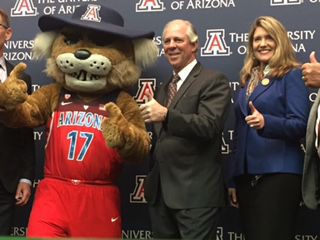The Arizona Board of Regents has promised Robert C. Robbins a compensation package of $988,000 per year for three years to lead the University of Arizona as its next president. That’s a whopping 46 percent increase over the current president’s pay.
The price tag is startling for several reasons. At just a shade under $1 million annually, Robbins will come to town as one of, if not the, highest-paid public employee in Pima County — not including the UA basketball and football coaches — and in an income bracket far above the vast majority of residents.
Robbins took a hit of about 17 percent to come to the UA. He’d been paid $1.2 million-plus as CEO of Texas Medical Center. He told the Star last month that he expected to take a “major pay cut” at the UA and said, “I’ve never really been motivated by money.”
We don’t know the intricacies of the negotiations. Perhaps Robbins asked for more but settled for $988,000 — or maybe he followed the lead of the University of Texas-Austin president who two years ago took the job for $750,000 in base pay, even though he was offered $1 million because, he said, taking that much money in tough times wouldn’t be right.
However the $988,000 figure came to be, the Arizona Board of Regents has set the baseline compensation for every future UA president. An individual may accept a new job for less money than he or she had been making, but that’s not the trend for institutions, including the UA. Robbins has the potential to earn even more if he meets specific goals set out by the regents.
Robbins has a significant challenge even before he’s set foot in the president’s office within the renovated walls of Old Main: The regents’ largesse comes amid tuition and student-fee increases and at a time when many families struggle to afford the roughly $12,000 resident tuition. Graduate students and adjunct instructors have been fighting for better pay and health insurance, and budget cuts are felt across campus.
Students, faculty, employees, parents and alumni pay attention to such things. Students talk about it in class and draw the conclusion that that’s why they have to pay more in tuition and fees. The intricacies of a contract where some of the compensation is covered by private donors (which raises other questions) doesn’t erase the impression that students who are taking on tens of thousands in student-loan debt are paying for a very high-priced president.
Then there’s the Arizona Legislature. Spending princely sums on a president while pleading for more funding isn’t likely to help the UA’s legitimate case for more public money.
The details — that Robbins’ $108,000 annual retirement contribution, the $70,000 yearly housing allowance and $10,000 annual car allowance will be paid with “funding sources other than legislative appropriations, except to the extent Arizona law authorizes the use of these funds in payment of this allowance” — doesn’t dull the impression that the UA can afford a pricey president while pleading poverty to the public.
The regents also failed to correct what has been exposed as a weakness in policy exposed by current UA President Ann Weaver Hart’s decision to take a paid paying position on the board of DeVry University.
Like Hart, Robbins must agree only that his UA job is “primary” and that any outside activities “must not conflict with or interfere with” his responsibilities as president, and he must make an annual report to the regents about all outside compensation he receives.
The regents should have required that any outside activities receive their prior approval.
Robbins’ compensation package reminds us of something that happened in 2002, when Peter Likins was president of the UA. He received about $320,000 in pay and benefits, and then-Arizona State University Michael Crow was hired at more than $500,000 a year. The Board of Regents wanted to boost Likins’ pay so the UA would still have the highest-paid president.
Likins’ refused a pay increase, saying when it was first mentioned that he would be embarrassed to accept it.
“We need money in these universities. It’s terribly difficult for us to finance our continuing activities. I would just be uncomfortable receiving a substantial increase in my current salary at this time,” said Likins . Instead, he returned the more than $100,000 increase in base pay increase to the UA.
When he took the job, Robbins spoke about doing more with less, how times are tight and how students struggle financially to afford college.
He said the right things. We hope he will recognize that his hefty paycheck is his first challenge as president and how he handles this situation will set the tone for his entire time at the UA.





